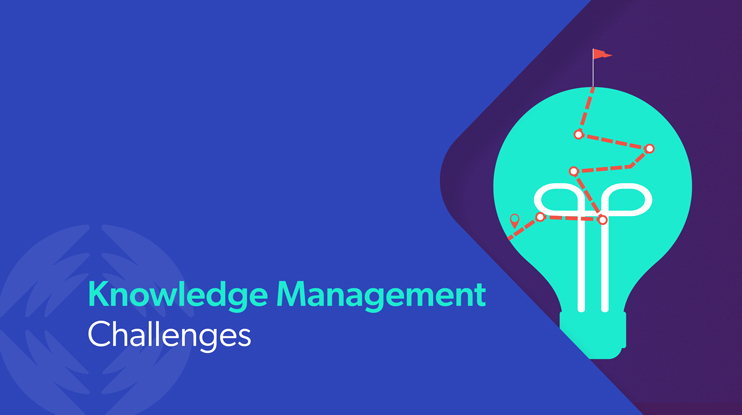Is your company struggling to create a knowledge sharing culture? You might be comforted to know you’re not alone.
Despite the millions of dollars invested in this area in the last decade, organizations still suffer from a lack of success in their knowledge management programs.
And it’s being felt at the employee level, especially when teams can’t find the information they need to do their job well. Our recent survey revealed that 34% of employees feel burnt out and frustrated when they lack tools for their day-to-day tasks. Around 7% would even consider leaving their company.
Why has improvement stalled? The three top obstacles to successful knowledge sharing are:
- People: Not enough resources to create and maintain content
- Process: Lack of defined processes around knowledge creation and management
- Technology: Poor search technology or badly designed portals
Whether you’re creating a knowledge sharing process from the ground up, or transforming an existing one, you’ll likely face all of these obstacles on your journey.
Where do you begin when tackling these challenges? Ask yourself the following questions.
1. Who should be involved in the knowledge transformation process?
Many organizations will say that sharing knowledge is every employee’s job. And that’s true, in a sense; knowledge comes from every department and level of the company. Still, it’s crucial to have dedicated knowledge experts directing and leading the process, because if everyone is accountable, then nobody is accountable.
To support the dedicated knowledge experts who will author and edit the majority of the content, you’ll need enough resources and people dedicated to search, distribution, data analysis, and more. More important than having enough people, however, is making sure you have the right people involved in the collaboration.
Having input from the executive level down to the support team will provide a well-rounded view of your knowledge management system’s impact. It will also ensure that the technical side of the process is being overseen by both individuals who have a clear understanding of your current system and those with a vision for the new one.
Key players in the Knowledge Management team can include:
- Executive sponsor
- Change agents
- IT
- Cross-departmental champions
- Marketing
- Program owner
- Knowledge manager
- Subject matter expert
2. How do you encourage knowledge management participation?
Participation in a company’s knowledge management system can include content creation, using search portals to help customers or inform daily work, sharing and talking about knowledge with colleagues, and more. The more that employees interact with and contribute to the overall knowledge base, providing valuable data, the smarter an AI-powered search platform can become in delivering relevant content to the right audiences. A company culture of knowledge sharing is critical to the success of the system.
Employees focus their efforts in the areas they believe their managers and the organization value the most. And because not all companies tie knowledge sharing to employee performance, productivity, and/or incentive compensation, motivation can be low or nonexistent.
Introducing gamification elements is one way to encourage shared knowledge. The first step is putting processes in place to track key data. For example, how often are support agents attaching content to closed cases? A leaderboard can then be implemented to provide benchmarks and encourage people to increase their use of existing content.
Another idea is to build relevant knowledge participation into the system. For example, program a rule that does not allow support staff to close a case until they either attach existing related articles or create one to fill that knowledge gap.
Though many employees often believe that hoarding knowledge is more beneficial to their own personal advancement and gain, individual job performance is surely better enhanced when all are encouraged to share knowledge with each other. You gain just as much by learning from others, and when one person hoards, that discourages others from sharing as well — no one is better off.
Relevant reading:The Key to Hybrid Work? Connecting, Not Expanding, Your Tech Stack
3. What comes first: content or search?
If you’re starting a knowledge sharing platform with very little or no content, it might seem logical to hold off investing in a portal or intelligent search until you have built up a more substantial library of articles. After all, why encourage people to start using the system before you have much knowledge available?
Unfortunately, there are a few flaws with this approach. The first is that the creation of content will never be finished because employees continue to learn and create solutions. There is a risk that the process will get stuck in a cycle of creation and storage, never moving on to distribution and use.

The second is that a focus on content creation and storage can be inefficient without the data gathered through early implementation of smart search. The earlier you implement machine learning, the sooner you’ll understand exactly what content and formats customers need first and how search language differs between customers and support staff.
This point also applies to companies with existing content databases who are switching from one management system to another. There’s a big gap between what we think our customers need versus what they actually need, and without the data, this disconnect can leave you falling behind.
AI-powered search will also simplify content storage processes that might have been handled manually. For example, good metadata and tags are added automatically, search results can be personalized to the individual, and content can be found no matter how it’s structured or where it lives.

By focusing on content creation and distribution simultaneously, you can direct resources and expertise where they are most needed.
Dig Deeper
Where does your organization fall within the knowledge management maturity model? Identify where you stand with this walkthrough.






